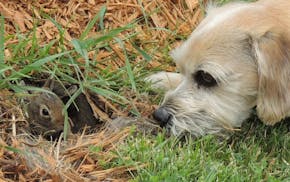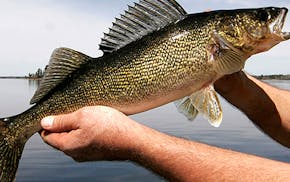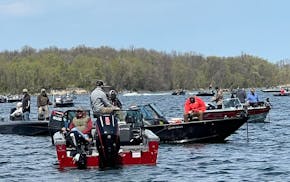For dog owners in particular, there's a certain dread in discovering a nest of baby bunnies in the yard. Blind, hairless and helpless, few creatures seem as vulnerable.
The Wildlife Rehabilitation Center of Minnesota reported in mid-April that 481 bunnies had been brought in during a single week. Eastern cottontails are difficult mammals to rehab, though, and do best if left in place. If you attempt to move the nest, the mother is unlikely to find and recognize them.
The center suggests putting a laundry basket over the nest to protect bunnies from pets. A wire basket also works. Put it on the nest in the morning and take it off before sunset so that the mother has access at dawn and dusk to feed her babies.
Mothers have an average of five babies in a nest made of grass and her own fur. Mom usually stays away except for feeding time. This helps keep predators from noticing the nest.
Rabbits fill a large role in the food chain as meals for raptors, foxes, coyotes, wolves, raccoons, skunks, weasels, humans, and more.
They draw the most ire when they munch on humans' coveted vegetable gardens. If they're wiping out food sources or damaging property, it is legal to live trap cottontails and relocate them or to humanely dispose of them. More details, including tips for protective fencing to keep out rabbits, can be found on the Minnesota Department of Natural Resources website.
If you do find an injured rabbit, it can be brought to the rehabilitation center in Roseville, which has intake forms online, or another permitted wildlife rehabilitator in your region of the state. No matter how much a starry-eyed child may beg "Can we keep it?" it's illegal to care for and keep wild animals in Minnesota.
If you do find a healthy nest you want to protect, the daily covering with a laundry basket should last only about three weeks until the bunnies can leave the nest and fend for themselves. But maybe keep that basket handy. Cottontails can breed again within hours of giving birth and have multiple litters each year.
Lisa Meyers McClintick has freelanced for the Minnesota Star Tribune since 2001 and volunteers as a Minnesota Master Naturalist.

Backyard bunny nest? Here's how to protect the tiny babies from Fido.

Anderson: These 10 Minnesota lakes will get you hooked on walleye fishing

Get ready for Minnesota's fishing opener: Here's what you need to know

Trump names NorthMet copper-nickel mine in Minnesota a federal priority

